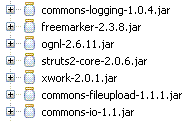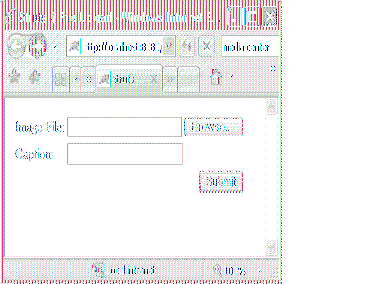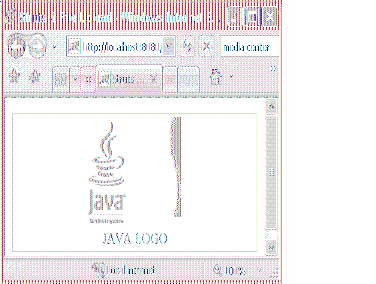Struts2.0实现上传
前一阵子有些朋友在电子邮件中问关于Struts 2实现文件上传的问题, 所以今天我们就来讨论一下这个问题。
实现原理
Struts 2是通过Commons FileUpload文件上传。Commons FileUpload通过将HTTP的数据保存到临时文件夹,然后Struts使用fileUpload拦截器将文件绑定到Action的实例中。从而我们就能够以本地文件方式的操作浏览器上传的文件。
具体实现
前段时间Apache发布了Struts 2.0.6 GA,所以本文的实现是以该版本的Struts作为框架的。以下是例子所依赖类包的列表:
首先,创建文件上传页面FileUpload.jsp,内容如下:
<% @ taglib prefix = " s " uri = " /struts-tags " %>
<! DOCTYPE html PUBLIC "-//W3C//DTD XHTML 1.0 Transitional//EN" "http://www.w3.org/TR/xhtml1/DTD/xhtml1-transitional.dtd" >
< html xmlns ="http://www.w3.org/1999/xhtml" >
< head >
< title > Struts 2 File Upload </ title >
</ head >
< body >
< s:form action ="fileUpload" method ="POST" enctype ="multipart/form-data" >
< s:file name ="myFile" label ="Image File" />
< s:textfield name ="caption" label ="Caption" />
< s:submit />
</ s:form >
</ body >
</ html >
清单2 FileUpload.jsp
在FileUpload.jsp中,先将表单的提交方式设为POST,然后将enctype设为multipart/form-data,这并没有什么特别之处。接下来,<s:file/>标志将文件上传控件绑定到Action的myFile属性。
其次是FileUploadAction.java代码:
清单3 tutorial/FileUploadAction.java
在FileUploadAction中我分别写了setMyFileContentType、setMyFileFileName、setMyFile和setCaption四个Setter方法,后两者很容易明白,分别对应FileUpload.jsp中的<s:file/>和<s:textfield/>标志。但是前两者并没有显式地与任何的页面标志绑定,那么它们的值又是从何而来的呢?其实,<s:file/>标志不仅仅是绑定到myFile,还有myFileContentType(上传文件的MIME类型)和myFileFileName(上传文件的文件名,该文件名不包括文件的路径)。因此,<s:file name="xxx" />对应Action类里面的xxx、xxxContentType和xxxFileName三个属性。
FileUploadAction作用是将浏览器上传的文件拷贝到WEB应用程序的UploadImages文件夹下,新文件的名称是由系统时间与上传文件的后缀组成,该名称将被赋给imageFileName属性,以便上传成功的跳转页面使用。
下面我们就来看看上传成功的页面:
<% @ taglib prefix = " s " uri = " /struts-tags " %>
<! DOCTYPE html PUBLIC "-//W3C//DTD XHTML 1.0 Transitional//EN" "http://www.w3.org/TR/xhtml1/DTD/xhtml1-transitional.dtd" >
< html xmlns ="http://www.w3.org/1999/xhtml" >
< head >
< title > Struts 2 File Upload </ title >
</ head >
< body >
< div style ="padding: 3px; border: solid 1px #cccccc; text-align: center" >
< img src ='UploadImages/<s:property value ="imageFileName" /> ' />
< br />
< s:property value ="caption" />
</ div >
</ body >
</ html >
清单4 ShowUpload.jsp
ShowUpload.jsp获得imageFileName,将其UploadImages组成URL,从而将上传的图像显示出来。
然后是Action的配置文件:
<! DOCTYPE struts PUBLIC
"-//Apache Software Foundation//DTD Struts Configuration 2.0//EN"
"http://struts.apache.org/dtds/struts-2.0.dtd" >
< struts >
< package name ="fileUploadDemo" extends ="struts-default" >
< action name ="fileUpload" class ="tutorial.FileUploadAction" >
< interceptor-ref name ="fileUploadStack" />
< result name ="success" > /ShowUpload.jsp </ result >
</ action >
</ package >
</ struts >
清单5 struts.xml
fileUpload Action显式地应用fileUploadStack的拦截器。
最后是web.xml配置文件:
< web-app id ="WebApp_9" version ="2.4"
xmlns ="http://java.sun.com/xml/ns/j2ee"
xmlns:xsi ="http://www.w3.org/2001/XMLSchema-instance"
xsi:schemaLocation ="http://java.sun.com/xml/ns/j2ee http://java.sun.com/xml/ns/j2ee/web-app_2_4.xsd" >
< display-name > Struts 2 Fileupload </ display-name >
< filter >
< filter-name > struts-cleanup </ filter-name >
< filter-class >
org.apache.struts2.dispatcher.ActionContextCleanUp
</ filter-class >
</ filter >
< filter >
< filter-name > struts2 </ filter-name >
< filter-class >
org.apache.struts2.dispatcher.FilterDispatcher
</ filter-class >
</ filter >
< filter-mapping >
< filter-name > struts-cleanup </ filter-name >
< url-pattern > /* </ url-pattern >
</ filter-mapping >
< filter-mapping >
< filter-name > struts2 </ filter-name >
< url-pattern > /* </ url-pattern >
</ filter-mapping >
< welcome-file-list >
< welcome-file > index.html </ welcome-file >
</ welcome-file-list >
</ web-app >
清单6 WEB-INF/web.xml
发布运行应用程序,在浏览器地址栏中键入:http://localhost:8080/Struts2_Fileupload/FileUpload.jsp,出现图示页面:
选择图片文件,填写Caption并按下Submit按钮提交,出现图示页面:
更多配置
在运行上述例子,如果您留心一点的话,应该会发现服务器控制台有如下输出:
INFO: Unable to find 'struts.multipart.saveDir' property setting. Defaulting to javax.servlet.context.tempdir
Mar 20 , 2007 4 : 08 : 43 PM org.apache.struts2.interceptor.FileUploadInterceptor intercept
INFO: Removing file myFile C:\Program Files\Tomcat 5.5 \work\Catalina\localhost\Struts2_Fileupload\upload_251447c2_1116e355841__7ff7_00000006.tmp
清单9 服务器控制台输出
上述信息告诉我们,struts.multipart.saveDir没有配置。struts.multipart.saveDir用于指定存放临时文件的文件夹,该配置写在struts.properties文件中。例如,如果在struts.properties文件加入如下代码:
清单10 struts配置
这样上传的文件就会临时保存到你根目录下的tmp文件夹中(一般为c:\tmp),如果此文件夹不存在,Struts 2会自动创建一个。
错误处理
上述例子实现的图片上传的功能,所以应该阻止用户上传非图片类型的文件。在Struts 2中如何实现这点呢?其实这也很简单,对上述例子作如下修改即可。
首先修改FileUpload.jsp,在<body>与<s:form>之间加入“<s:fielderror />”,用于在页面上输出错误信息。
然后修改struts.xml文件,将Action fileUpload的定义改为如下所示:
< interceptor-ref name ="fileUpload" >
< param name ="allowedTypes" >
image/bmp,image/png,image/gif,image/jpeg
</ param > color: #





评论